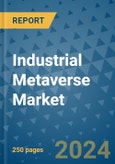The global industrial metaverse market is witnessing unprecedented growth, driven by a confluence of factors including technological advancements, increasing adoption across diverse sectors, and rising demand for remote collaboration solutions. According to the latest analysis from the publisher, the industry is projected to expand from a revenue of US$ 120 billion in 2024 to an astounding US$ 700 billion by 2031, representing a remarkable compound annual growth rate (CAGR) of 29.0%.
This product will be delivered within 1-3 business days.
Key Trends Driving Market Expansion:
- Diverse Sector Adoption:
- Simulation and Prototyping:
- Digital Twins Integration:
- Advanced Technologies Integration:
Rising Demand in Automotive Manufacturing:
- Product Design and Development:
- Virtual Testing and Validation:
- Assembly Line Optimization:
Impact of IoT Integration:
- Real-time Monitoring and Analysis:
- Remote Asset Management:
Regional Insights:
- Asia Pacific:
- United States:
- China:
Technology Landscape:
- Virtual Reality (VR):
- Remote Collaboration:
Competitive Analysis:
Leading players in the global industrial metaverse sector are focusing on innovation and strategic partnerships to solidify their market positions and meet evolving customer demands.Leading players in the global industrial metaverse sector, including:
- Microsoft
- Meta
- Unity Software
- Epic Games
- NVIDIA
- HTC
- Sony
- Magic Leap
- Apple
Global Industrial Metaverse Market Segmentation:
By Technology:
- Virtual reality (VR)
- Augmented reality (AR)
- Mixed reality (MR)
By Application:
- Training and Simulation
- Remote Collaboration
- Product Design and Development
- Asset Management
- Supply Chain Management
- Customer Service
- Manufacturing
- Logistics
- Healthcare
- Education
By Region:
- North America
- Latin America
- Europe
- Asia Pacific
- Middle East and Africa
This product will be delivered within 1-3 business days.
Table of Contents
1. Executive Summary
2. Market Overview
3. Price Analysis
4. Global Industrial Metaverse Market Outlook, 2018 - 2031
5. North America Industrial Metaverse Market Outlook, 2018 - 2031
6. Europe Industrial Metaverse Market Outlook, 2018 - 2031
7. Asia Pacific Industrial Metaverse Market Outlook, 2018 - 2031
2. Latin America Industrial Metaverse Market Outlook, 2018 - 2031
3. Middle East & Africa Industrial Metaverse Market Outlook, 2018 - 2031
4. Competitive Landscape
5. Appendix
Companies Mentioned
- Microsoft
- Meta
- Unity Software
- Epic Games
- NVIDIA
- HTC
- Sony
- Magic Leap
- Apple
Methodology

LOADING...








